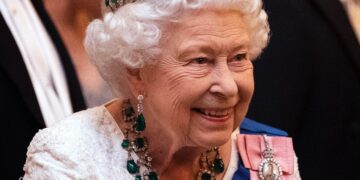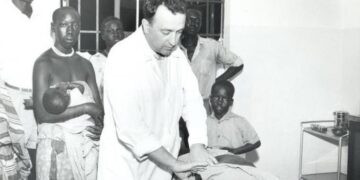FATHER GIUSEPPE AMBROSOLI THE HEALING MAN OF GOD Extracts from the book, “Fr. Giuseppe Ambrosoli:
the healing man of God” written by Fr Aurelio Boscaini, a Comboni missionary.
O n 1st February 1956, Father Giuseppe embarked on a ship in Venice destined for Africa. He was going to Kalongo in
Uganda where the Comboni Missionaries had arrived in 1910; fulfilling an ancient dream of Daniel Comboni after several decades of coming to Uganda. Earlier in 1943, Kalongo had expanded to a modest dispensary, run by the Comboni nurse, Sister Eletta Maniero. Then in 1949, Brother Angelo Avi transformed the clinic into a bigger dispensary and in 1954, the maternity ward was added. The fame of the hospital soon
spread. People moved from as far as Lira, Kitgum and Gulu to the hospital for treatment. With the increased number of patients, the idea of a large general hospital made its way. The soul of the project was Father Alfredo Malandra: In addition to maternity, Father Malandra dreamed of opening a school for midwives. And in 1954, he urgently needed the “scholastic-medical” person preparing for priesthood. “I want him immediately… See if you can speed up the time of his ordination”, he wrote to the Superior General.
After completing his theology course, Father Giuseppe was assigned to Kalongo, a place he was happy to live in and be part
of. For him, it was the concrete expression of the institute to which he had chosen to belong, and he felt it as a gift. He considered himself and his work as part of a family, the Combonis, and the local Church project, of Gulu. What’s more, he knew that the Combonis evangelise as a community – “like a cenacle of apostles”, the founder had written in the rules – and this impressed him. Father Giuseppe was to work with Fr Malandra in Kalongo. When Fr Giuseppe arrived, Fr Malandra was so happy to meet him. “You will stay here with me forever… And be sure to stay healthy,” he told Fr Giuseppe.
When he arrived in Kalongo in February 1956, Father Giuseppe didn’t imagine that all his Comboni missionary service would take place there. Fr Malandra requested Br. Angelo Avi and teacher Gino Owiny go pick him up from Gulu. When they reached Gulu, Father Giuseppe told them he would sit at the back of the truck.
Brother Avi, who may have been guilty of holy naivety but was a man of exceptional goodness said nothing. He told the story much later.
Eight years after his university graduation, with a modest surgical preparation, Father Giuseppe was set to work. He spent most of the time at
the dispensary, where many patients presented themselves to him. His first patients were two Acholi people: one mauled by a lion, the other attacked by a buffalo.
Father Giuseppe’s dream was to fulfil Fr Malandra’s dream of having a school for midwives in the hospital. Unfortunately, he had an Italian degree in Medicine, which was not recognised in Uganda.
Father Giuseppe had to attend a one-month course at the obstetric department in Mulago hospital Kampala.
In 1958, after the visit of Uganda’s new governor, Sir Frederich Crawford and the arrival of a volunteer Scottish doctor, Jane MacShane and Dr Pietro Tozzi in Kalongo, the school was opened, and the first course was inaugurated. At the end of the course, they would be issued with diplomas, which were recognised in every health facility in the colony and all English-speaking countries.
Father Malandra had also dreamt of a big hospital, and Fr Giuseppe had to roll up his sleeves and turn into a labourer: he dug stones, transported them himself with the truck and took care of brick manufacturers. Kamillo Oyaro Orik was a school teacher in one of the schools next to the hospital. He would sometimes send the school children to help Fr Giuseppe with the building material.
He worked tirelessly and was not afraid to get his hands dirty. He surprised people in the beginning but as time went on, they admired and helped him. He became a skilled truck driver: he would drive to get sand and stones from the river and buy iron sheets and cement in Gulu.
He was honest and realized that he risked being overwhelmed by activities and would forget the essentials. So he stopped to reflect and told himself: “I must try to impersonate the Master in me when he was caring for the sick who came to him….if hey could see Jesus in me!” He immediately understood that to win the hearts of the Africans, he had to use infinite kindness and become closer, carefully look, judge and act, more neighbourly and more in solidarity with those who lived next to him and those dependent on him.
Father Giuseppe’s daily schedule began with him making physical effort both in the operating theatre and in the outpatient clinic. He would begin with the most difficult and demanding operations and then move on to the minor ones. His surgeries ranged from bronchial asthma, sometimes very delicate and risky, to restore normal or better breathing, to orthopaedics, with sweaty operations to ensure a faster recovery, to the ones to close tropical ulcers, up to the removal of cataracts.
He also worked as the director of the structure and teacher in the nursing school. He was able to stay at the operating table for six hours in a row, and if he had been called for an emergency after the six hours, he would return to the operating room. He earned himself a name from the locals who referred to him as Ajwaka Madit (the great physician) or Doctor Ladit (the great doctor).
The qualification of “great” is surprising to Africans, who do not miss anything about a person’s attitudes and see him working in silence and humility, two qualities that are not typical of those who occupy an important role or have uncommon academic gifts.
















